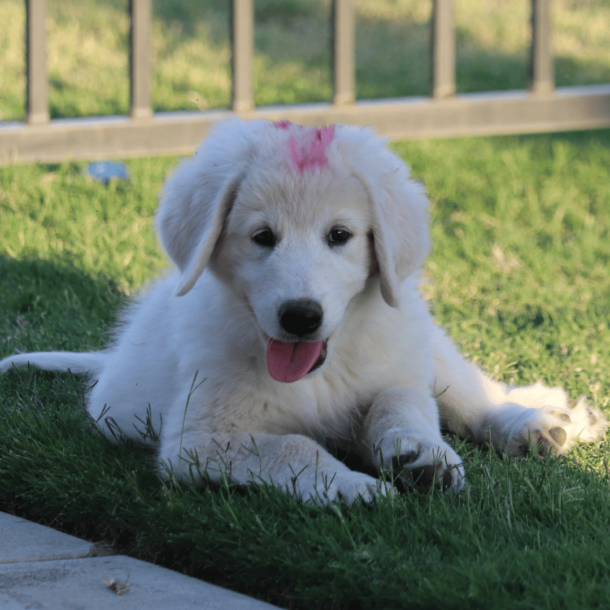Last Updated on November 6, 2025 by Kim Crawmer, KPA CTP, LFDM
I’ve given your puppy an exceptional start. Now it’s your turn to finish what we’ve begun.
Over the past 12 weeks, you’ve followed this litter’s journey from helpless newborns to confident young livestock guardian dogs. You’ve seen the science-based methods, intentional socialization, and meticulous care that creates the foundation for exceptional livestock guardian dogs.
But here’s the truth that separates successful livestock guardian dog placements from heartbreaking failures: What I do in the first 12 weeks matters, but it’s only part of the formula. What YOU do in the next 12 months is the missing part of the equation.
I can provide the perfect foundation—and I have. But without educated, committed LGD owners who understand how to continue their livestock guardian dog’s development, even the best-prepared puppies can struggle.
This final post isn’t about celebrating what we’ve accomplished. It’s about preparing you for the partnership that determines whether your LGD puppy succeeds or fails.

What Your Livestock Guardian Puppy Has Learned So Far
Let me be clear about what 12 weeks of comprehensive LGD development creates—and what it doesn’t.
The Foundation We’ve Built
Environmental Confidence: From birth, these puppies have experienced constant variety: music, TV shows, Bluey, Taylor Swift, country music, the weekly garbage truck, road traffic, delivery vehicles, farm equipment, and countless daily activities. They’ve learned that new sights and sounds are normal, not threatening.
Livestock Integration: Starting at 3 weeks, puppies have lived full-time with carefully selected trainer goats. They’ve learned livestock “language”—body signals, appropriate boundaries, respectful interaction. They see goats, chickens, ducks, geese, turkeys, and barn cats as family, not prey or toys.
Multi-Species Social Skills: They’ve been mentored by Genevieve (Auntie Genny), their mother, their father, and other adult Maremmas. They’ve met visiting dogs of different breeds. They understand that dogs come in many shapes, sizes, and temperaments.
Human Trust: Regular interaction with my grandchildren (toddlers to teens), adult visitors, goat customers, and delivery people has taught them that humans of all ages and types are safe, trustworthy, and sometimes quite fun. They’ve been handled, groomed, painted, walked, and loved by dozens of people.
Basic Handling: Regular grooming table sessions, nail trims, ear cleanings, and gentle all-over handling have prepared them for veterinary care and daily management. They’ve learned that standing calmly for examination leads to good things.
Introduction to Training: Starting around 4-5 weeks (when they’d reliably take food), we introduced clicker training. Not to create perfectly obedient dogs—that’s not what LGDs should be—but to teach them the fundamentals of learning and communication with humans.
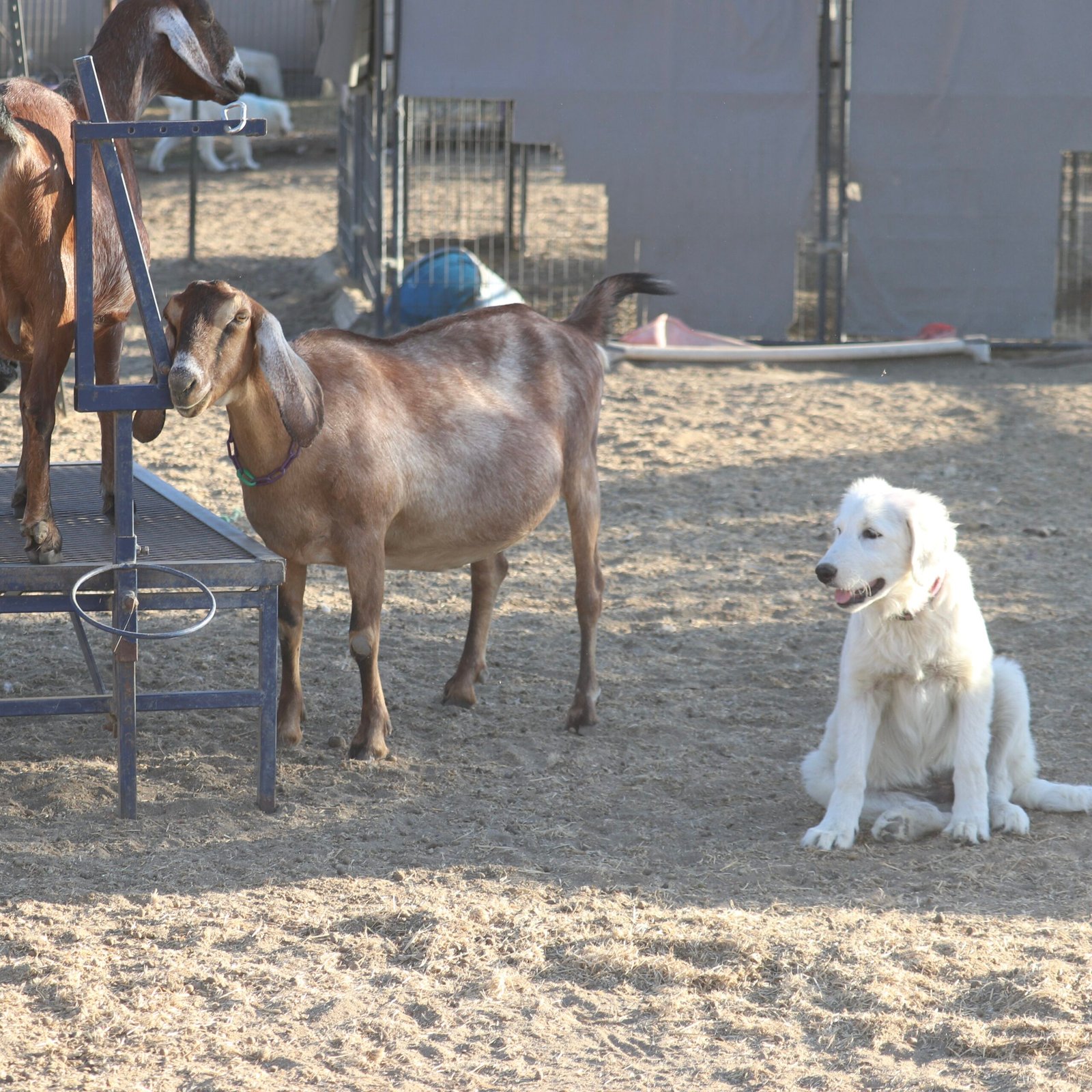
What they understand:
- The click sound means something yummy is coming
- Offering behaviors (like sitting politely) gets attention
- Four feet on the floor = reinforcement; jumping = ignored
- Waiting at gates instead of rushing through = treats
- Searching for tossed treats (foundation for future training)
- Hand targeting
- Eye contact and basic engagement
What we practice constantly:
- Gate manners (impulse control training)
- Not jumping on people for attention
- Manding (offered sits for interaction)
- Calm behavior during handling and grooming
- Following simple targeting cues

What This Is NOT
These puppies are NOT:
- Fully trained in obedience cues and behaviors
- Finished with their development
- Ready to work livestock independently
- Able to handle all situations without guidance
- Going to magically “just know” what to do
At 12 weeks, your Maremma livestock guardian dog puppy is a confident, well-socialized baby with an exceptional foundation.
What happens next is entirely up to you.
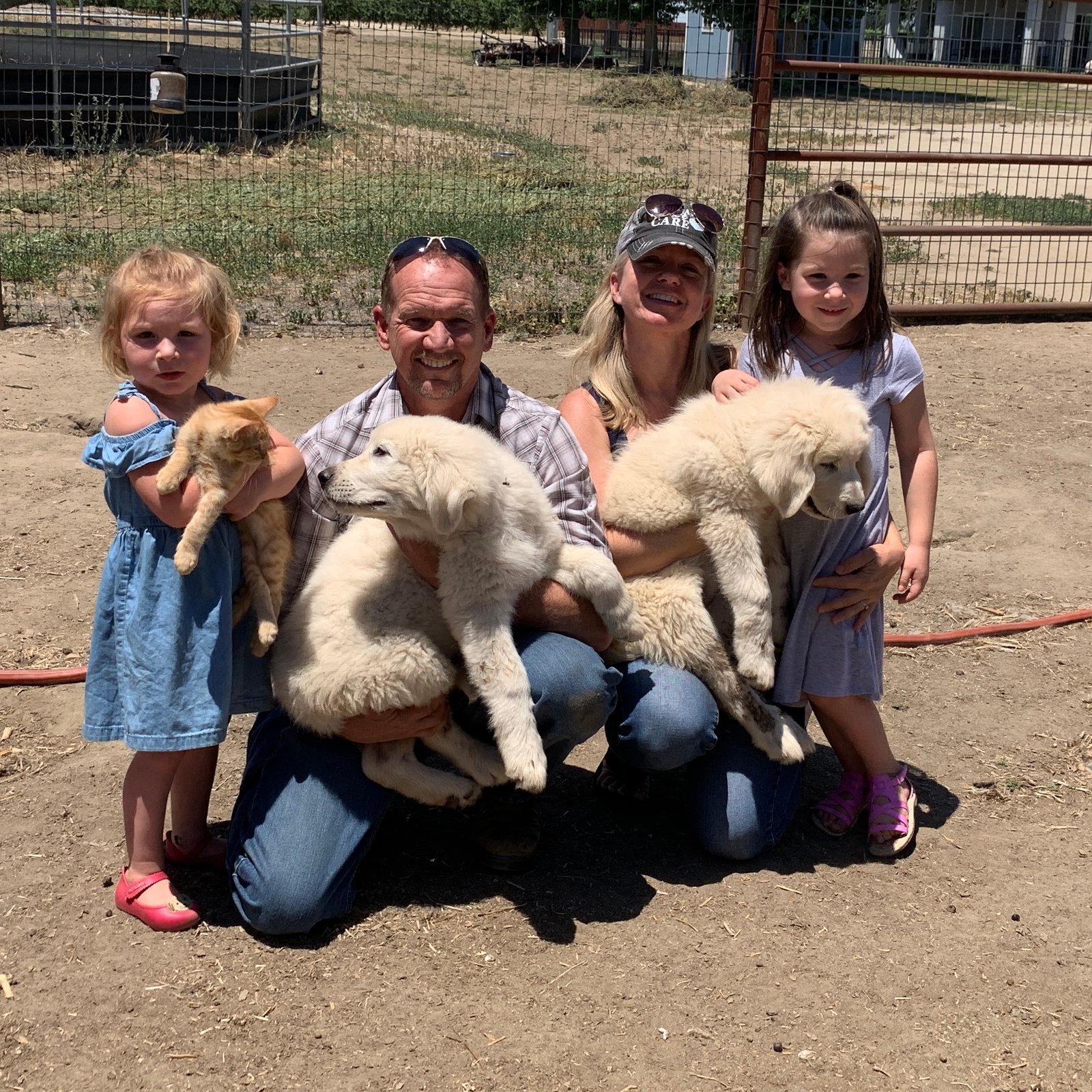
The Critical Truth About LGD Success
After 10+ years of breeding and consulting with countless owners, I can tell you definitively: The predictor of success isn’t solely the puppy’s preparation—the owner’s education also matters.
I regularly consult with heartbroken owners whose dogs failed despite:
- Impressive pedigrees
- Good genetics
- Proper early socialization
- Clean health records
- Outstanding breeder support
What went wrong? The owners didn’t educate themselves.
They assumed good breeding was enough. They thought instinct would handle everything. They expected the puppy to “just figure it out.”

Meanwhile, I watch families with more challenging situations—rescue dogs, poorly socialized adults, dogs from backyard breeders—succeed beautifully because they invested in THEIR OWN education.
Study + Practice = Success
It’s that simple. And that hard.
You can buy the best-prepared puppy in the world, but if you don’t understand:
- How dogs learn and communicate
- What livestock guardian breeds specifically need
- How to read stress signals and body language
- How to set up environments for success
- How to continue socialization and training
- When to push forward vs. when to step back
You’ll struggle. Your dog will struggle. Your livestock might pay the price.

How to Prepare for Livestock Guardian Dog Success
Physical Preparation
Before your puppy comes home, you need:
Safe Space Setup:
- Secure area near (but not yet IN WITH) livestock
- Shelter from weather
- Fresh water access
- Safe fencing (no gaps a puppy can squeeze through)
- Escape-proof setup (livestock guardian breeds are athletic and clever)
Essential Supplies:
- High-quality puppy food
- Stainless steel bowls or clip-on fence feeders
- Appropriately sized harness and leash
- ID tags with your contact information
- Grooming supplies (brush, nail clippers, etc)
- Age-appropriate toys
- Proper shelter from the elements
Veterinary Relationship:
- Established relationship with a vet experienced with large breed dogs
- First appointment scheduled within 72 hours of pickup
- Emergency vet information readily available

Insurance (CRITICAL): I provide every puppy family with a breeder code for Trupanion pet insurance. I cannot emphasize enough how important this is.
Livestock guardian dogs work in challenging environments. Injuries happen. Illnesses occur. The cost of emergency veterinary care can be thousands of dollars—far more than annual insurance premiums.
Get your insurance set up BEFORE pickup. I have a comprehensive article about why this matters and how to do it:
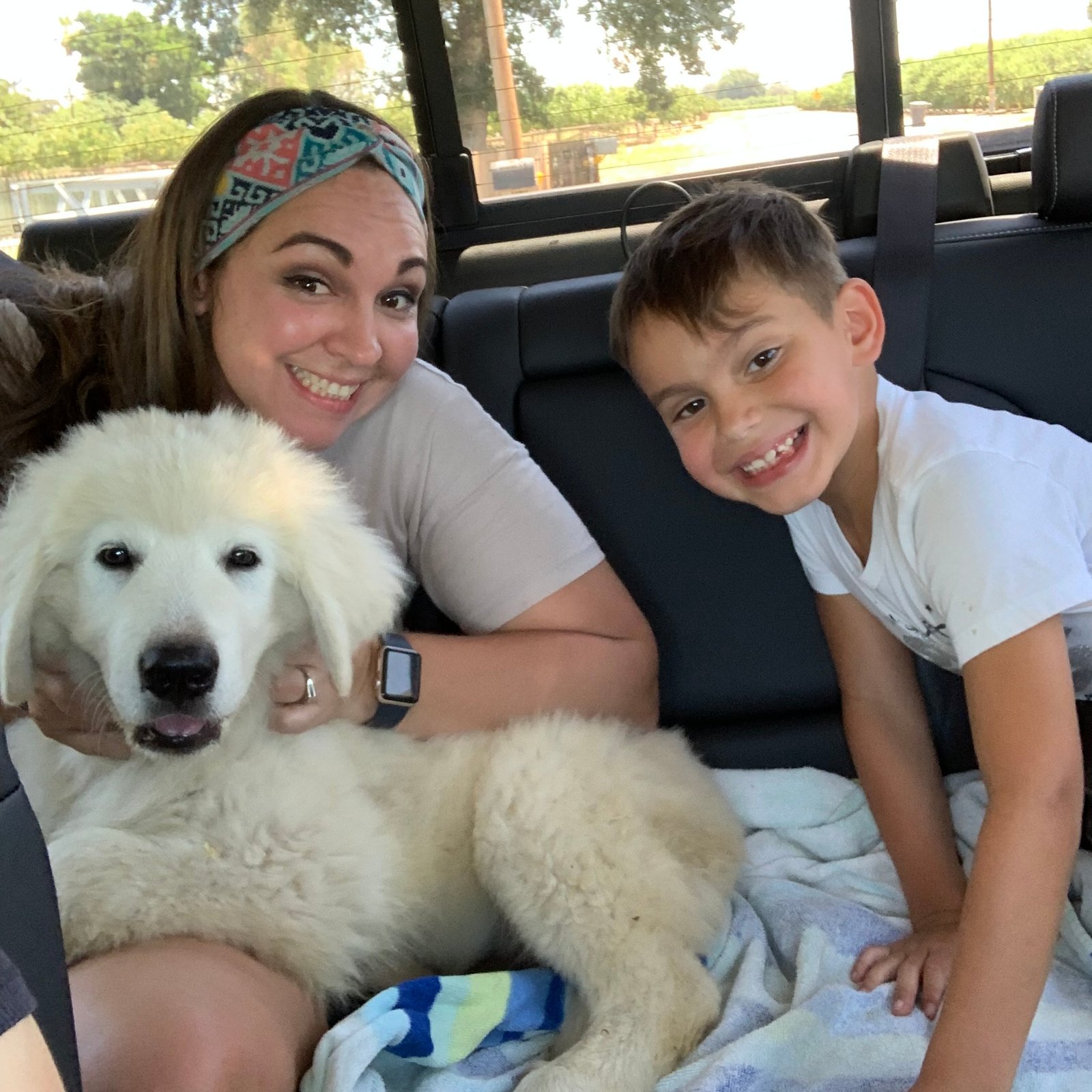
Educational Preparation (THE MOST IMPORTANT PART)
This is where most people fail—and where you cannot afford to.
Minimum recommended education BEFORE your puppy arrives:
1. Training Foundation: Take the Karen Pryor Academy Dog Trainer Foundations course. Yes, the entire thing. Before your puppy comes home.
This isn’t optional if you want to succeed. The course teaches:
- How dogs actually learn (not how you assume they learn)
- Three core training techniques: capturing, targeting, shaping
- How to use markers and reinforcers effectively
- Reading body language and emotional states
- Management vs. training (and when to use each)
Cost: $249. Value: Priceless.
This is the single best investment you can make in your LGD’s success.
Read our complete post on the topic with a link to the course here:

2. Understanding Your Dog: Enroll in The DIAL Method® program. This isn’t traditional training—it’s a framework for understanding what your dog actually needs and how to work WITH their guardian nature instead of fighting it.
This is especially critical because:
- LGDs are fundamentally different from other breeds
- They’re independent thinkers, not obedient pets
- They need different things than your Border Collie or Golden Retriever
- Understanding their needs prevents most common problems
Cost: $50 for the program alone, $150 for program + personalized consultation (consultation are free for our puppy clients)

3. Essential Reading:
“Meet Your Dog” by Kim Brophey This book will transform how you understand canine behavior. It explains why dogs do what they do based on their breed history, individual personality, and environmental needs. Essential for anyone serious about understanding their guardian.
“On Talking Terms with Dogs: Calming Signals” by Turid Rugaas Learn to read what your dog is actually communicating through body language. This skill alone can prevent countless problems and misunderstandings.
Both books combined: Under $30. The education: Invaluable.
4. Ongoing Learning: I’m launching a membership program specifically for livestock guardian dog families. This will include:
- Monthly training modules
- Problem-solving guidance
- Community support from other LGD families
- Video demonstrations
- Direct access to my expertise
Details coming soon—current puppy families will receive priority access.

Livestock Integration Planning
Your puppy has learned that livestock are family. Now you need to continue that education in YOUR specific environment.
Gradual integration protocol:
Phase 1: Observation Phase
- Puppy lives adjacent to livestock with visual access
- Supervised visits through a shared fenceline where puppy can see/smell the stock but not directly interact
- Livestock become familiar with puppy’s presence (feeding stock near the fence can facillitate this)
- Watch for calm, interested behavior in both species (not excessive excitement in either)
Phase 2: Controlled Introduction
- Brief, supervised interactions on a leash or long line
- Older, calm livestock introduced first
- Positive reinforcement for appropriate behavior
- Immediate removal if play gets too rough or arousal too high
Phase 3: Increased Access
- Longer supervised sessions
- Begin short unsupervised periods (15-30 minutes) with very calm, puppy-experienced livestock
- Gradually increase time as confidence and appropriate behavior build
Phase 4: Independence Building
- Extended unsupervised time with proven livestock
- Continue monitoring closely
- Intervention if inappropriate play or behavior emerges
This timeline for these phases depends on each individual puppy and the livestock. Some puppies move faster, some need more time. Your job is to observe, assess, and adjust based on what YOUR puppy and YOUR livestock need.
Never rush this process. Taking extra time now prevents lifelong problems.

Continuing Your Livestock Guardian Dog’s Training Journey
The clicker training foundation I’ve provided is exactly that—a foundation.
What you need to continue:
Daily Practice (5-10 minutes, 2-3 times per day):
- Continue shaping the behavior you want to see more of
- Use a clicker to mark the behaviors you like (like calm, quiet behavior with stock and polite greetings with humans)
- Always pay your puppy for those behaviors (click = treats!)
- Ignore the behaviors you don’t like (behaviors that aren’t reinforced gradually fade)
- Practice gate manners and impulse control
- Reinforce calm greetings (four on the floor)
- Work on hand targeting and simple behaviors
- Play “find it” games with scattered treats
Weekly Skills:
- Practice leash walking a couple of days a week; make sure to allow your dog to sniff and enjoy the walks
- New environments and experiences
- Meeting new people and animals
- Continued handling and grooming
- Expanding repertoire of behaviors
Monthly Goals:
- Increased reliability in distractions
- Better impulse control
- Stronger communication between you and your LGD
- Growing confidence in varied situations
Remember: You’re not training an obedience champion. You’re developing a confident, manageable livestock guardian dog who can think independently while still communicating and cooperating with you as their partner.
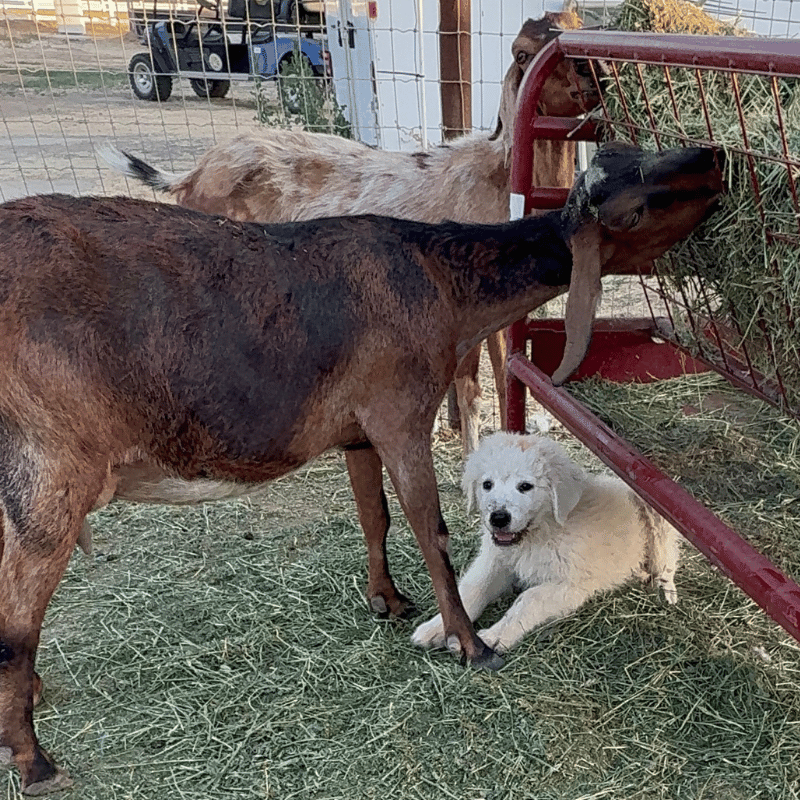
What to Expect as Your Livestock Guardian Dog Grows
At 12 weeks, your puppy:
- Is still a baby
- Has a short attention span
- Will make mistakes (many mistakes!)
- Needs frequent rest and downtime
- Is still learning what’s expected
- Will test boundaries as they mature
At 6 months, your puppy:
- Is fully in adolescence (buckle up!)
- May regress in training
- Will test boundaries MORE
- May become more “zoomie” with livestock and need temporary “supervised visits” for a time, so as to not develop bad habits and undesired motor patterns
- Needs continued guidance and structure
- May still not be ready for full independence with livestock (it depends on the individual puppy)
At 12 months, your dog:
- Is approaching maturity
- Should show reliable guarding behaviors (though this varies by dog)
- Still benefits from ongoing training
- May have occasional adolescent moments
- Could show same-sex aggression with other dogs due to hormone swings
- Is becoming the livestock guardian you envisioned
At 2 years, your dog:
- Reaches full maturity (though some dogs take a bit longer)
- Should be a confident, reliable livestock guardian
- Continues to benefit from engagement and training
- Has become a full partner in livestock protection
This is a long-term investment. Plan accordingly.

How I Continue Supporting You and Your Livestock Guardian Dog
Choosing a Prancing Pony Farm puppy doesn’t end at pickup. It’s the beginning of a lifelong partnership.
I provide:
- Lifetime email and phone support
- Training consultation when you’re stuck
- Problem-solving guidance
- Celebration of your successes
- A community of fellow LGD families who understand
When to reach out:
- Before integrating with livestock (let’s make a plan together)
- When behavior concerns emerge (early intervention prevents problems)
- When you’re celebrating successes (I love good news!)
- When you need reassurance (this journey has challenges)
- Anytime you’re unsure (better to ask than guess)
I’m invested in your success. Every puppy that thrives proves that this comprehensive approach works.

The Choice Is Yours
I’ve spent 12 weeks giving your puppy every advantage possible. Thousands of hours of observation, guidance, socialization, and care have created the foundation for an exceptional livestock guardian dog.
But I can’t come home with you.
The next phase is your responsibility:
- Continuing socialization and training
- Educating yourself through courses and books
- Setting up the puppy’s environment for success through
- Using Antecedent Arrangement to solve problems
- Reading and responding to your puppy’s needs
- Having patience through challenges
- Celebrating small victories
- Never giving up on the partnership
You have two choices:
Choice 1: Assume the puppy will “just figure it out” based on instinct and my preparation. Wing it when problems arise. Avoid investing time and money in your own education.
Result: Struggle. Frustration. Possible failure. Becoming another heartbreaking statistic about a livestock guardian that didn’t work out.
Choice 2: Recognize that you’re entering a partnership that requires YOUR growth as much as your dog’s. Invest in education. Practice what you learn. Reach out for help when needed. Commit to the long-term process.
Result: Success. A confident and trustworthy livestock guardian dog. A rewarding partnership. Becoming a success story that proves exceptional breeding + educated ownership = outstanding outcomes.
Which will you choose?

Final Thoughts
This series has documented 12 weeks of intensive LGD puppy development. You’ve seen the critical windows, the science-based methods, the meticulous care, and the countless hours that create properly prepared livestock guardian puppies.
But the most important lesson isn’t what I’ve done—it’s what happens next.
Exceptional livestock guardians require exceptional partnerships. I’ve provided one half of that equation. The rest is up to you.
Study. Practice. Reach out for help. Stay committed. Celebrate progress. Have patience.
Your LGD is worth it. Your livestock are worth it. YOU are worth it.
Welcome to the partnership. Let’s make this a success story.

Essential Resources Mentioned:
Training & Education:
- Karen Pryor Academy Dog Trainer Foundations Course
- The DIAL Method® Program
- “Meet Your Dog” by Kim Brophey
- “On Talking Terms with Dogs: Calming Signals” by Turid Rugaas
Insurance:
Ongoing Support:
- Email: kim@prancingponyfarm.com
- Membership program (launching soon – current families get priority access)
Questions? Reach out. I’m here to help you succeed.
📚 LGD Puppy Development Series:
- Part 1: The Critical Window: Why early socialization makes or breaks your LGD
- Part 2: From Helpless to Hero: the Remarkable Journey of LGD Development
- Part 3: The Puppy Parlor Method: How We Raise and Socialize LGD Puppies
- Part 4: Puppy Socialization for LGDs: Why Human Interaction Builds Better LGDs
- Part 5: Livestock Integration for LGD Puppies: From Observation to Interaction
- Part 6: Building Immunity: The LGD Health Protocols That Protect Your Investment
- Part 7: Child Socialization for LGDs: Why it's Crucial for Family Farms
- Part 8: LGD Socialization: Meet Genny, the Maremma Mentor Who Perfects Every Puppy's Education
- Part 9: Beyond the Puppy Parlor: What Your LGD Needs Next
This series has documented one litter’s journey, but the principles apply to every livestock guardian dog I’ve ever raised. Proper preparation + educated ownership = lifelong success. Thank you for following along, and thank you for committing to doing this right.
FAQs:
Q: When should I start livestock introductions with my LGD puppy?
A: Begin visual introductions as soon as you bring your puppy home, progressing slowly under supervision. Each puppy develops at a different pace.
Q: What training methods work best for livestock guardian dogs?
A: Positive reinforcement and clicker training build trust and cooperation—never use punishment-based methods.
Q: How long does it take for an LGD to mature?
A: Most reach full maturity around 2 years, though progress varies by individual and environment.



